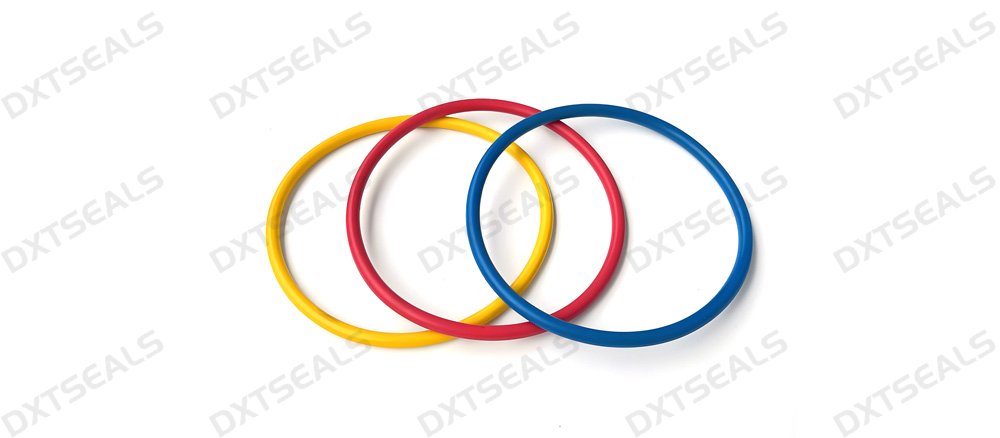Introduction
Hydraulic systems, which are widely used in various industries such as construction, manufacturing, and automotive, rely heavily on effective sealing solutions to maintain their functionality. Among the most common sealing components in these systems are rubber O-rings. These small but essential components play a crucial role in ensuring leak-proof seals and enhancing the overall performance of hydraulic systems. In this article, we’ll explore the importance of rubber O-rings in hydraulic systems, how they work, and why they are the preferred choice for many high-pressure applications.
1. What Are Rubber O-Rings and How Do They Work?
A rubber O-ring is a circular, flexible seal typically made from synthetic rubber or elastomeric materials. When installed between two surfaces, O-rings form a tight seal by compressing within the groove, effectively blocking the passage of liquids and gases. This compression allows the O-ring to withstand pressure, preventing fluid leakage and ensuring a reliable seal.
In hydraulic systems, rubber O-rings are used to seal various components, such as:
- Pumps
- Cylinders
- Valves
- Connectors
The versatility and reliability of rubber O-rings make them an ideal sealing solution for hydraulic systems across a wide range of industries.
2. The Role of Rubber O-Rings in Hydraulic Systems
✅ Leak Prevention
The primary function of rubber O-rings in hydraulic systems is to prevent fluid leakage. Hydraulic systems are often subject to high pressures, and without a reliable seal, hydraulic fluids can leak, leading to system failures, efficiency losses, and environmental hazards. Rubber O-rings create a tight seal that effectively prevents such leaks, maintaining the integrity of the system.
✅ Pressure Resistance
Hydraulic systems operate under high pressure, and it is crucial that seals can withstand these extreme conditions. Rubber O-rings are designed to compress and maintain their sealing properties under pressure, ensuring that hydraulic fluid stays contained within the system. Whether the pressure is low or high, rubber O-rings maintain a stable seal, ensuring optimal system performance.
✅ Minimizing Wear and Tear
Rubber O-rings also play a key role in minimizing friction and wear within hydraulic systems. As they compress between moving parts, they help reduce the wear on the components, which can extend the life of the system and prevent costly repairs. By creating a smooth, durable barrier, rubber O-rings ensure that the system operates more efficiently and effectively.
✅ Temperature Resistance
In addition to pressure, hydraulic systems often deal with varying temperatures. Rubber O-rings made from materials such as Nitrile (NBR), Fluorocarbon (FKM), and EPDM can handle a broad temperature range, from low to high temperatures, without losing their sealing effectiveness. This temperature resistance makes them ideal for use in systems exposed to extreme environmental conditions.
3. Why Rubber O-Rings Are Preferred in Hydraulic Systems
✅ Flexibility and Durability
One of the key reasons why rubber O-rings are preferred in hydraulic systems is their flexibility. The materials used in their construction allow them to adapt to the dynamic nature of hydraulic systems, which involve constant movement and shifting pressures. The durability of rubber O-rings ensures that they last over time, even under demanding conditions.
✅ Cost-Effectiveness
Compared to alternative sealing solutions, rubber O-rings are cost-effective while offering excellent sealing performance. Their simple design and widespread availability make them an affordable option for hydraulic systems of all sizes. With the proper material selection, rubber O-rings provide long-term value, reducing maintenance costs and system downtime.
✅ Versatility in Material Selection
Rubber O-rings come in a wide variety of materials, making it easier to select the best O-ring for a specific hydraulic application. Some common materials include:
- Nitrile (NBR): Offers excellent oil and fuel resistance, ideal for use in petroleum-based hydraulic fluids.
- Fluorocarbon (FKM): Known for high-temperature resistance and compatibility with aggressive chemicals, making it suitable for hydraulic systems exposed to extreme environments.
- EPDM: Provides superior resistance to water, steam, and ozone, ideal for hydraulic systems that require high levels of flexibility.
Choosing the right material ensures that the O-ring can withstand the specific demands of the hydraulic system and environment.
4. Choosing the Right Rubber O-Ring for Hydraulic Systems
Selecting the right rubber O-ring for a hydraulic system requires understanding the specific conditions in which it will be used. Key factors to consider when choosing an O-ring include:
- Pressure: Ensure the O-ring is rated for the pressure levels your hydraulic system will operate under.
- Temperature: Select an O-ring material that can withstand both the minimum and maximum temperatures of your system.
- Fluid Compatibility: Different materials offer varying levels of resistance to specific fluids, such as oil, water, or chemicals. Choose a material that is compatible with your hydraulic fluid.
- Size and Shape: Proper sizing is essential for the O-ring to fit securely in the groove, providing an effective seal.
By carefully evaluating these factors, you can choose the right rubber O-ring for your hydraulic system, ensuring optimal performance and reliability.
5. Conclusion
Rubber O-rings are an essential component in the operation of hydraulic systems, providing reliable sealing solutions that prevent leaks, reduce wear, and enhance system performance. Their ability to withstand high pressure, extreme temperatures, and various fluid types makes them the go-to choice for hydraulic applications in industries ranging from manufacturing to automotive.
When selecting rubber O-rings for your hydraulic system, consider factors such as pressure, temperature, and fluid compatibility to ensure the best possible performance. By choosing the right O-ring material and design, you can optimize the efficiency and longevity of your hydraulic systems.

